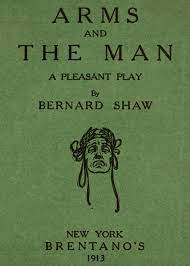Arms and the Man by George Bernard Shaw
“Arms and the Man” is a celebrated play written by George Bernard Shaw. First performed in 1894, this comedic masterpiece has captivated audiences for over a century with its witty dialogue, social commentary, and satirical take on love, war, and societal conventions. Set during the Serbo-Bulgarian War of 1885, “Arms and the Man” is a delightful exploration of the clash between romantic idealism and the harsh realities of war. With its memorable characters and thought-provoking themes, the play continues to be a significant contribution to the world of theater.
The play takes place in the home of the Petkoff family in Bulgaria. The central character, Captain Bluntschli, is a Swiss mercenary soldier who seeks refuge in Raina Petkoff’s bedroom. Raina, a young and idealistic woman, is engaged to Major Sergius Saranoff, a dashing and heroic officer. Bluntschli’s presence sparks a series of humorous and unexpected events that challenge the characters’ beliefs and expose their hypocrisies.
One of the key themes in “Arms and the Man” is the contrast between romanticism and realism. Shaw uses humor and satire to critique the romanticized notions of war and love prevalent in society. While Raina and Sergius embrace the romantic ideals of heroism and honor, Bluntschli, a pragmatic and unromantic figure, sees war as a business rather than a noble pursuit. Through Bluntschli, Shaw challenges the notion of war as a heroic endeavor, highlighting its absurdities and the true cost it exacts on individuals and society.
Another significant theme explored in the play is the role of gender and societal expectations. Shaw portrays Raina as a young woman who initially embodies the romantic ideals of a damsel in distress. However, as the play progresses, Raina’s facade begins to crumble, and she confronts the realities of love, relationships, and her own privileged position in society. Shaw challenges traditional gender roles by depicting Raina as a complex and independent woman who must reassess her values and find her own path.
The characters in “Arms and the Man” are richly developed and provide a wide range of perspectives. Captain Bluntschli, with his practicality and quick wit, serves as a voice of reason amidst the romantic illusions of the other characters. Raina evolves from a naive and idealistic young woman to a more mature and self-aware individual. Sergius, initially presented as a heroic and gallant officer, is revealed to be a shallow and pompous character, challenging conventional notions of heroism.
Shaw’s brilliant use of language and dialogue is one of the highlights of the play. His sharp wit and clever repartee add layers of depth and humor to the narrative. Shaw’s ability to blend comedy and social commentary allows him to explore weighty themes in an entertaining and accessible manner, making “Arms and the Man” an engaging and thought-provoking theatrical experience.
“Arms and the Man” has had a lasting impact on the world of theater and remains a popular choice for productions worldwide. Its examination of societal norms, the folly of romanticized ideals, and the complexities of human relationships continues to resonate with audiences. Shaw’s insightful critique of war, gender roles, and the illusions of society has made “Arms and the Man” a timeless classic.
In conclusion, “Arms and the Man” stands as a remarkable play that blends comedy, social commentary, and incisive dialogue to explore themes of war, love, and societal expectations. Shaw’s wit and intelligence shine through the memorable characters and their journeys, challenging audiences to question their own beliefs and perceptions. As a testament to its enduring relevance, “Arms and the Man” continues to be celebrated and performed, reminding us of the power of theater to entertain, provoke, and enlighten.
Key Facts
- Playwright: “Arms and the Man” was written by George Bernard Shaw, an Irish playwright and critic. Shaw is known for his wit, social commentary, and contributions to the development of modern drama.
- Year of Publication: The play was first performed in 1894 and published the same year. It quickly gained popularity and has since become one of Shaw’s most well-known works.
- Setting: “Arms and the Man” is set during the Serbo-Bulgarian War of 1885. The action takes place in the Petkoff family’s home in Bulgaria.
- Genre: The play is a comedy, blending humor, satire, and social commentary. Shaw uses wit and irony to explore serious themes and challenge societal norms.
- Themes: “Arms and the Man” addresses several themes, including the contrast between romantic ideals and reality, the futility and absurdity of war, the role of gender and societal expectations, and the hypocrisy of social conventions.
- Characters: The main characters in the play include Captain Bluntschli, Raina Petkoff, Major Sergius Saranoff, Catherine Petkoff, and Nicola. Each character represents different perspectives and undergoes personal transformations throughout the course of the play.
- Social Critique: Shaw uses “Arms and the Man” as a platform for social critique. He challenges the romanticized notions of war and love, exposes the hypocrisy of societal conventions, and questions traditional gender roles.
- Language and Dialogue: Shaw’s skillful use of language and witty dialogue is a hallmark of the play. The clever and insightful repartee between characters adds depth and humor to the narrative.
- Influence and Reception: “Arms and the Man” received positive reviews upon its release and has since become one of Shaw’s most frequently performed plays. Its enduring popularity and critical acclaim attest to its impact on the world of theater.
- Legacy: “Arms and the Man” continues to be celebrated and studied for its sharp social commentary, well-crafted characters, and skillful blend of comedy and satire. It remains a staple in theater repertoires worldwide.
These key facts provide an overview of the play “Arms and the Man” and its significance within the body of work by George Bernard Shaw. From its comedic elements to its exploration of societal norms and human relationships, the play offers a thought-provoking and entertaining experience for audiences.
Major Characters
“Arms and the Man” by George Bernard Shaw features several major characters who drive the narrative and contribute to the play’s themes and conflicts. Here are the key major characters:
- Captain Bluntschli: Captain Bluntschli is a Swiss mercenary soldier who seeks refuge in Raina Petkoff’s bedroom after escaping from battle. He is portrayed as a practical and pragmatic character, contrasting the romanticized ideals of war. Bluntschli’s wit, intelligence, and unromantic views challenge the beliefs of the other characters and offer a contrasting perspective on heroism and love.
- Raina Petkoff: Raina Petkoff is a young and idealistic woman engaged to Major Sergius Saranoff. She initially embodies the romanticized ideals of war and love, but her perceptions are challenged when she encounters Captain Bluntschli. Throughout the play, Raina undergoes a transformation as she confronts the realities of war and love, questioning her own beliefs and societal expectations.
- Major Sergius Saranoff: Major Sergius Saranoff is Raina’s fiancé and a celebrated war hero. He represents the traditional ideals of heroism, honor, and masculinity. However, Sergius’s character is gradually revealed to be shallow and pompous, highlighting the disparity between appearance and reality.
- Catherine Petkoff: Catherine Petkoff is Raina’s mother and a prominent figure in Bulgarian society. She is portrayed as an energetic and enthusiastic character, often preoccupied with social status and appearances. Catherine’s comedic moments stem from her attempts to uphold societal conventions while navigating the challenges presented by the events of the play.
- Nicola: Nicola is the Petkoff family’s practical and cunning servant. He often serves as a source of comic relief through his shrewd observations and witty remarks. Nicola’s character embodies the tension between social class distinctions and the pursuit of self-interest.
These major characters interact and collide, driving the play’s plot and contributing to its themes. Shaw expertly crafts their personalities and uses them to explore the contrast between idealism and reality, question societal conventions, and challenge traditional notions of heroism and love. The dynamics between these characters and their personal growth form the core of “Arms and the Man” and make the play a captivating and thought-provoking theatrical experience.
Minor Characters
In addition to the major characters, “Arms and the Man” by George Bernard Shaw also features several minor characters who play important supporting roles in the story. While they may have less stage time than the main characters, they contribute to the overall plot and themes of the play. Here are some of the notable minor characters:
- Louka: Louka is a maid in the Petkoff household. She is an ambitious and headstrong character who challenges the social order and expectations placed upon her as a servant. Louka becomes involved in a romantic entanglement with Sergius, adding an element of intrigue and further complicating the relationships in the play.
- The Russian Officer: The Russian Officer is a character who appears briefly in the play. He serves as a reminder of the ongoing conflict and the larger context of the war. His presence highlights the transient nature of alliances and the political realities that influence the characters’ lives.
- The Man: The Man is a servant who delivers a chocolate cream soldier to Raina in the opening scene of the play. Though he has minimal dialogue, his presence sets the stage for the subsequent events and establishes the central conflict involving Captain Bluntschli.
- Major Petkoff: Major Petkoff is Raina’s father and Catherine’s husband. While he does not have a significant role in the play, his character represents the conventional military figure and provides moments of humor and commentary on the bureaucratic aspects of war.
- Officers and Soldiers: Various officers and soldiers appear throughout the play, representing the larger context of the war and serving as a backdrop for the main events. They highlight the contrast between the romanticized notions of war and the realities faced by those involved in the conflict.
These minor characters contribute to the overall atmosphere and themes of “Arms and the Man,” adding depth to the narrative and supporting the development of the major characters. Each character brings their own perspective and contributes to the social commentary and comedic elements of the play. While they may have less prominence, their presence is crucial in shaping the dynamics and conflicts within the story.







